With a history steeped in agriculture it is natural that New Zealand’s farmers, shepherds and shearers have become known throughout the world for their skill and toughness. Many have travelled, to teach and work in foreign countries, but few have been invited to Buckingham Palace, appeared on late night American television or been honoured by the leader of the Soviet Union. Only one: Godfrey Bowen.
Walter Godfrey Bowen was born in Hastings, New Zealand, in 1922. He was named after his father, a sheep farmer of Craggy Range, Havelock North. Godfrey attended Havelock North Primary School from 1927 to 1932 and had aspirations to one day becoming a lawyer. However his family moved to Te Puke in the Bay of Plenty and his father decreed (due to the stresses of the Depression years) that he couldn’t go to secondary school and had to milk cows instead. With his brothers Eion, Ivan and Ken, he began working as a shearer at the age of 16. All the Bowen boys became accomplished shearers. They all had an edge, especially Ivan and Godfrey. These two had a massive edge, one over the rest of the world’s shearers, a talent that appeared almost God-given.
From the outset Godfrey displayed an incredibly natural apitutude for shearing, and over the course of his career was to transform shearing techniques.
In 1938 during his first season, as a 16-year-old, his best day’s tally was 204 sheep. At that time the top shearers in the country could not manage more than 300. By the time he was 19, Bowen’s personal best would be 322, an enormous tally for those days considering the equipment used and the standard of the sheep.
When World War II broke out, Bowen along with most young New Zealand men, enlisted to serve his country overseas. New Zealand served a dual role during the war: supplying men to fight in the Pacific, Europe and North Africa, and supplying food and raw materials for the allies. “Manpower”, the wartime government body established to direct the labour force, decided the best way Bowen could aid the defence against Nazism was through full time sheep shearing. In 1945, however, he was called up, and trained with a Commando unit, but the war ended before he left New Zealand.
The Bowen Technique
Bowen’s role took him to many farms around the central North Island and allowed him to observe and work with the old hands of the trade.
The strain on sheep shearers is unbelievable. Considerable strength and stamina is needed at all times, and shearers are constantly working in an awkward, bent position. They are only able to straighten their back after each sheep is shorn.
The shearing technique used in the 1940s had been evolving since 1888, when the first shearing machines were introduced into New Zealand. Blade shearing required the shearer to use short movements for the scissor-like cuts, a technique that continued with machine shearing. In 1905, however, Australian shearer Jim Powers started using long strokes to clip the wool. He described it as “going right from the breezer to the sneezer”, and with this new style, managed to shear an unprecedented 300 merinos in eight hours.
The next major breakthrough happened around 1912. Harry Hawkins of Wairoa further added to the speed with which a sheep could be shorn by using downward strokes from the brisket to the groin. These techniques were further advanced over the next few years, mainly by New Zealanders. Sheep numbers were growing and with this came the need for increased daily tallies.
Bowen was by nature an excellent observer and he learnt quickly. His aim was to perfect a continuous shearing action combined with the lowest possible energy output. He adopted the techniques of various shearers, incorporating all the positives he saw. For example, he once saw a shearer with a withered arm who allowed the sheep to roll into position because he didn’t have the strength to turn them himself. From this Bowen developed a new technique for holding the sheep.
Bowen would test these new techniques working with his brother Ivan. One would try the new method, the other would work alongside using the traditional way as a comparison.
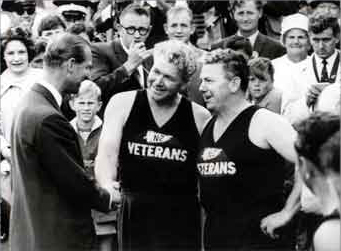
Ivan (centre) and Godfrey (right), winner and runner-up respectively in the first Golden Shears open final, meet Prince Philip during the Shears’ Royal Command Performance in Lower Hutt 1965. Copyright The Dominion, Wellington
From this experimenting evolved the famous Bowen Technique. The single greatest attribute of the style was Bowen’s use of the non-shearing hand to stretch out the skin on the sheep. This made the wool on the shorn fleece even, a much-valued attribute for buyers. Uneven fleeces mean more wool is left on the sheep or on the woolshed floor and, if only for aesthetic reasons, will never attract the highest prices. Eventually the Bowen Technique was adopted by shearers all over the world, adding billions of dollars of value to the international wool industry.
Even more influential on New Zealand’s economy, however, was Ivan and Godfrey’s idea of a second shear, in additon to the usual spring/early summer shear. Prompted by the wartime demand for wool they started shearing sheep in autumn. Many thought sheep shorn in autumn would not survive through winter, but they not only survived, but thrived, Two shears a year are now routine throughout the country.
As Eugene Grayland said in Famous New Zealanders in 1967:
“Because of Godfrey Bowen’s experiments with technique, shearers throughout the world are clipping sheep at a rate which was unheard of before and getting more wool off them as well. Bowen’s is a wonderful achievement.”
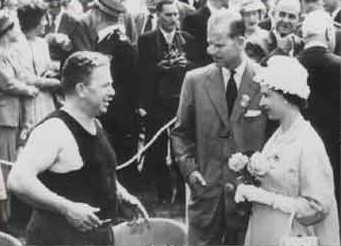
Godfrey Bowen meets Queen Elizabeth and Prince Philip c.1965 Copyright The Dominion, Wellington
Contests and Accolades
After the war Bowen stopped shearing full time. He studied accountancy and started managing the family sawmilling business, his interest in shearing having turned from professional to sporting. For the next seven years he was a regular on the circuit of A&P shows and field day shearing competitions. He won most of the competitions he entered, and in those he didn’t, he came second to his brother. Ivan won the first inaugural International Golden Shears title in 1960. Godfrey came second.
What is now known as the Bowen Technique was developed jointly by Godfrey and Ivan. The two were super-competitive, and easily the best shearers the world had ever seen. On the shearers’ stand there was very little separating the talents of the two brothers, Ivan’s five World Championship titles is testament to his incredible ability, and Godfrey also won many World Championship titles.
For the Bowens, competition was in the blood. During the war years Godfrey, 5′ 7″ and 16 stone, had been a New Zealand Army boxing champion, and a North Island Army rugby representative.
On January 6, 1953 Godfrey broke the world record for shearing sheep: 456 full-wool sheep in nine hours. New Zealand was still living high on the sheep’s back, and this feat turned him into an overnight celebrity. He did a nationwide demonstration tour raising money for the Returned Services Association and other charities, raising £14,000.
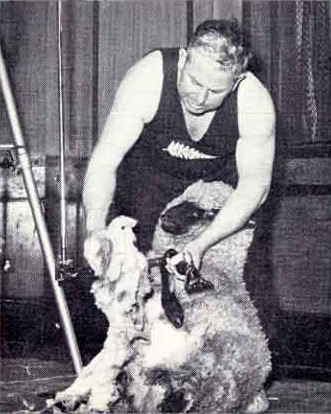
Godfrey Bowen age 42 gives shearing demonstrations in Britain 1964 Famous New Zealanders, by Eugene Grayland
Breaking the world record changed Bowen’s life. By the end of 1953 he had left the sawmilling business and was now chief shearing instructor for the New Zealand Wool Board. The Board saw the value of being associated with Bowen: not only could his famous shearing technique add value to the national clip, but being an articulate public speaker, he would be valuable in promoting New Zealand’s wool overseas.
In 1954 Bowen, as an employee of the Wool Board, formed a team with 30 instructors and they established a course at Lincoln and Massey Universities. This was a world first. Shearing had been regarded as a lowly occupation, mundane and menial; Bowen elevated it and demonstrated the value that good, uniform, shearing could bring to the country.
For the next 30 years Bowen’s life revolved around shearing and the promotion of New Zealand wool. New records would be broken as he travelled far from the rolling hills of Te Puke.
In 1956 with eight other Wool Board instructors, he set a team world record by shearing 3157 sheep in nine hours. Bowen’s personal tally for the day was 407. In 1957 he broke the world record again by shearing 463 sheep in nine hours.
In 1956, at the invitation of the British Wool Marketing Board, he made his first visit to the UK. The crowds that gathered to watch his shearing demonstrations were in awe and disbelief at his shearing exploits. In Ireland there was some controversy as farmers believed the sheep had been drugged to make them more placid. In other places farmers would bring their biggest and most bad tempered animals to shows in an attempt to test Bowen’s skill. He was more than a match of them.
At this time the rest of the world was still shearing with blades and scissors. Bowen watched in disbelief as six British shearers worked on one sheep: four shearing a leg each, another shearing the sides and another the head. The wool length was usually inconsistent and the sheep would end up covered in cuts. This method was also slow: these six shearers averaged 30 sheep in an hour; alone Bowen averaged 45 in the same time.
Nureyev Quality
Several years later The Guardian was to write about the famous shearer using language far removed from the earthy bluster of a typical New Zealand wool shed:
“Godfrey Bowen’s arms flow with the grace of a Nureyev shaping up to an arabesque, or a Barbirolli bringing in the cellos. Watching him shear is even more remarkable that seeing a finely tuned machine.”
The paper compared him with other New Zealand heroes.
“Unquestionably he remains the greatest shearing exponent of all time. His records have made him a folk hero in his own country with only three contemporary equals – Hillary, Upham, the double VC, and Clarke, the rugby fullback. But his real importance is as a key figure in world economics.”
The author was no doubt referring to how the Bowen Technique removes more wool per sheep than other shearing methods.
Hero to the People
In 1960 Bowen was awarded an MBE at Buckingham Palace for his services to the sheep industry. As if to prove his worth for the award, a short time later he shore 559 Welsh mountain sheep in nine hours, one of his most famous and remarkable feats.
By now countries outside the Commonwealth were interested in learning how to shear with the Bowen Technique. He was invited to Japan, Afghanistan, Argentina, India and Pakistan on demonstration and instruction tours. In 1963 he was invited to the Soviet Union to train their shearers. His five week stay in the communist empire was a sensation, culminating in him being invested in the Kremlin by Premier Nikita Khruschev with the two top Soviet honours: Hero of Labour, and The Star of Lenin. The awards were rare even for a Soviet citizen and almost never given to a foreigner.
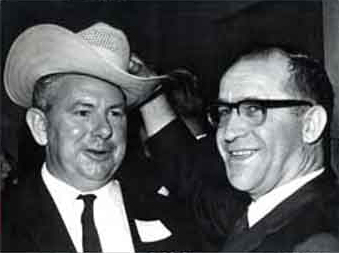
Godfrey Bowen is presented with cowboy hat by Oregon farmers c. 1967 Permission The Dominion, Wellington
Expo and Agrodome
Bowen was invited to produce the New Zealand outdoor exhibit at the 1970 World Expo in Osaka, Japan. In the previous 15 years he had shown that not only was he a shearer and educator of extraordinary ability, but he was also a brilliant public speaker and cultural ambassador for New Zealand. His blend of humour and philosophy, his good-natured ruggedness, his intelligence and his enthusiasm won him friends all over the world. He was a guest on the British talk show Parkinson and invited to appear on the famous ‘Tonight Show with Johnny Carson’ in the United States. With the edge cheekiness typical of a Kiwi, he tried to encourage Carson to have a go at shearing. He was also invited to Afghanistan and asked to return to India and the Soviet Union.
The World Expo, with shearing demonstrations, exhibitions of different breeds and a display of trained sheep was a hit and earned Bowen New Zealand’s tourism award, the Newman Award.
Taking the theme from the World Expo, Bowen opened Agrodome in 1971. On an 80 ha block 10km from Rotorua he and local farmer George Harford, established this theme park dedicated to the New Zealand farm. The Agrodome has won many tourism awards over the years and a smaller operation has travelled to festivals and shows in the United States and Britain.
Harford was a sheep and beef farmer from Reporoa. The Agrodome combined his farming talents with Bowen’s shearing ability and both saw the potential of displaying Kiwi rural culture in a show setting. Today the Agrodome is run by both the founders’ sons, Warren Harford and Paul Bowen. They have also opened a bigger version in Japan that hosts one million visitors a year.
In 1980 fire completely destroyed the Agrodome building. Showing style in the face of adversity, Ivan Bowen, who was the Agrodome’s main presenter and showman, performed the world famous sheep show on a nearby hill in front of 100 visitors, while the destroyed building smouldered in the background.
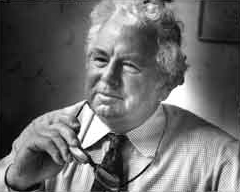
Godfrey Bowen aged 61 before his retirement from the NZ Wool Board 1983. Copyright The Dominion, Wellington
Science, Art
Godfrey Bowen wrote several books about shearing, and New Zealand farming in general. He was a renowned public speaker, and a lay preacher to all denominations. He kept a very busy schedule of appointments both nationally and internationally. Ever the sportsman, he mastered awn bowls and won two Wellington Provincial Championships (1986 and 1987).
Godfrey Bowen died in 1994 at the age of 72, and his legacy is long and lasting. The Bowen family’s contribution to the world of shearing is unparalled and the family-owned Agrodome is a permanent fixture on the tourist map.
At 84, brother Ivan is the embodiment of rural New Zealand toughness. He can still shear a sheep in around 60 seconds; he still competes in the Golden Shears Veterans’ Competition, and keeps fit with a daily routine that includes 100 press-ups.
To the present day, New Zealand shearers are regarded as the best in the world. Men such as Snow Quinn, who dominated the New Zealand and international scene between 1965 and 1972; David Fagan, who won 11 consecutive Golden Shears titles and has 437 open wins to his credit; John Fagan (older brother of David, some say he was the Godfrey Bowen of the 80s), was also world record holder and Golden Shears champion; Darrin Forde, the current world record holder shearing 720 crossbred ewes in nine hours; Dion Morrell, who holds the world record for shearing 505 Merrino ewes in nine hours; Alan MacDonald who holds the current world record for shearing 831 lambs in the same time; Cartwright Terry who with a swift 19 or 20 blows has undressed a lamb in what is believed to be the world’s fastest time: 21.08 seconds; Colin King who has been a Golden Shears champion is regarded as the best left handed shearer the world has seen, and Keith Wilson, the legendary shed shearer who, in December 1999, broke the unofficial world record by shearing 871 sheep in one incredible sweat-soaked day.
In any given year approximately one third of all British sheep are shorn by New Zealanders. The shearers get to see the world; the farmers get the best. This is due to the way shearing is viewed in New Zealand: as a science and an art. Those who shear competitively approach their sport as any top athlete does, with fitness, training and commitment. They see shearing as something to be proud of and to master. The way Bowen saw it.
Sources
Web references:
For the Agrodome website:
http://www.agrodome.co.nz
[Accessed February 2000]
Books:
Bowen, Godfrey. (1982) The Ringers’ Stand, Kerslake Billens and Humphery Ltd, New Zealand
Bowen, Godfrey. (1971) New Zealand and its Sheep, National Sheep Centre, Levin, New Zealand
Bowen, Godfrey. (1955) Wool Away: the Art and Technique of Shearing, Whitcombe and Tombs Ltd, New Zealand
Grayland, Eugene. (1967) Famous New Zealanders, Whitcombe and Tombs Ltd, New Zealand













This was an amazing read! I grew up next door to Ivan Bowen in Rotorua, but only knew the latter part of this story. Ivan used to take me out to the Agrodome to help out from about age 10, which I used to love. Only met Godfrey the once, but saw Ivan shear many a sheep in those Agrodome shows. I used to let the different breeds of sheep up on stage, timed with a pre-recorded tour of NZ sheep breeds narrated by Godfrey. In Covid times, with my mother still living in the same house, I pass by what was Ivan's house frequently and think of him alot, so reading this really meant alot to me - thank you so much
I sheared with Mr. Bowen at the PNE back in the Seattle World Fair. I personally sheared in 60 seconds. Mr. Bowen 45 seconds. I would be 14 years old. My job was caretaker of the sheep we brought in from Salt Spring Island for the daily competition. Was a great experience for a young person. Now hearing he was a legend.
Amazing it helped me lots with my work and used this for mainly the whole thing!!! Keep it up
I enjoy, lead to I discovered ecactly what I used to be looking for. You've ended my 4 day long hunt! God Bless you man. Have a greatt day. Bye
I fondly remember 21 years ago when Mr. and Mrs. Bowen opened their home to me for a visit right around this same time of year. Being a California native, I was far from home traveling with a family I was working for as a nanny. I knew Mr. Bowen was a champion sheep shearer, but at the time did not realize what a truly amazing man he was. I came across your wonderful article today and wanted to say thank you. Sandy Lee, Product Support Specialist USA